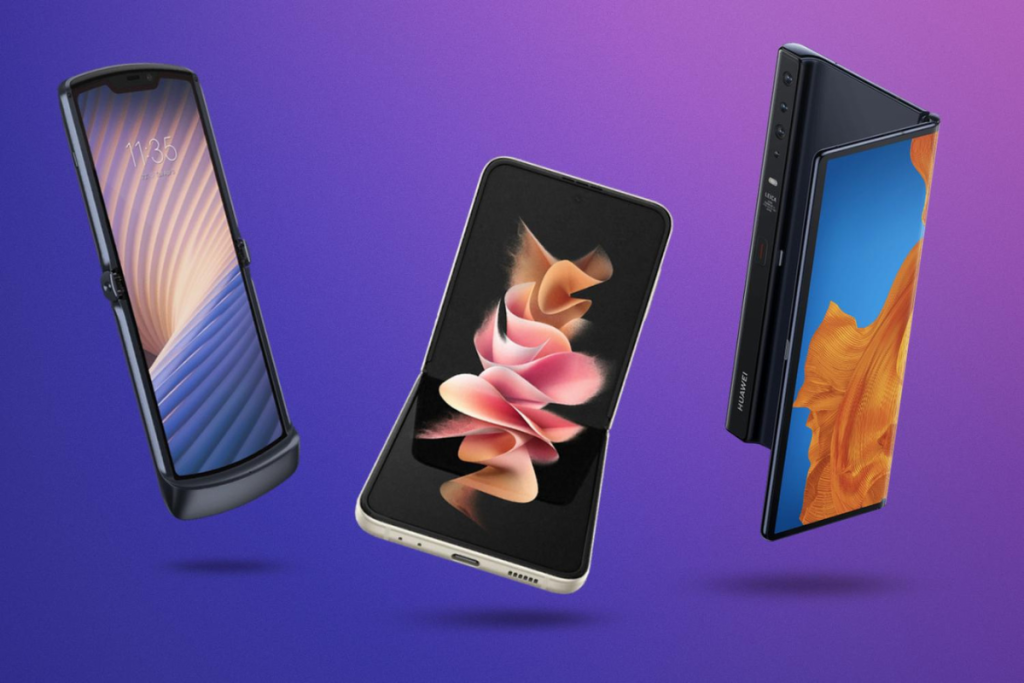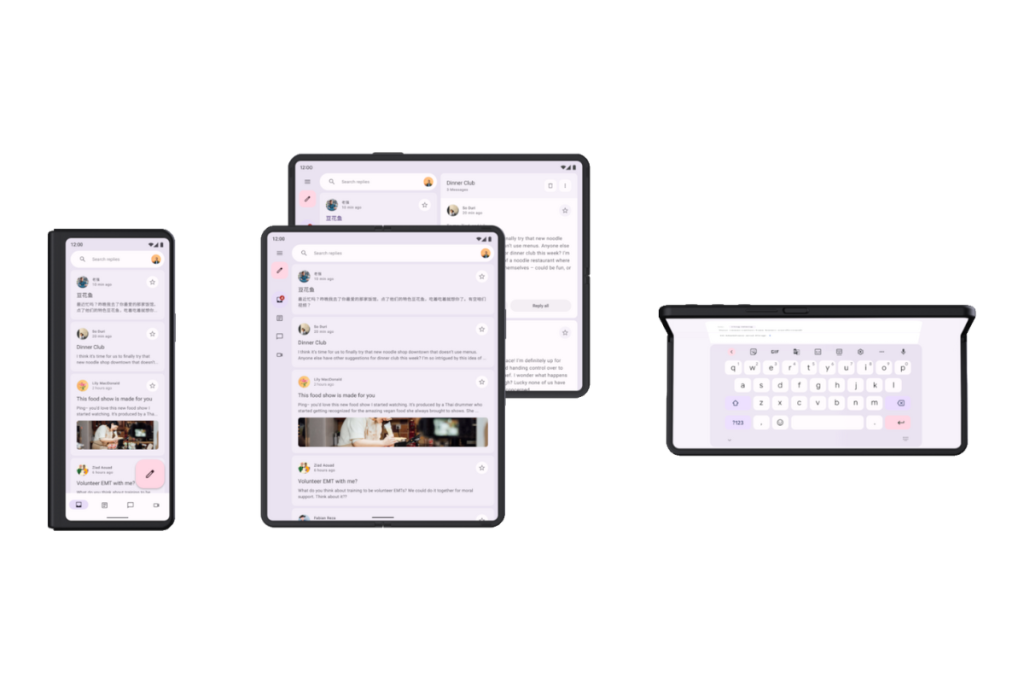
-
Apexlink
Real Estate
-
DLS
General Insurance
-
DMV
Government
-
Entiger
Fintech
-
GIS Mapping
Gas & Petroleum
-
HMS
Employee Benefit
-
HAWA
Government
-
Harley
Community
-
IHG
Hotel & Tourism
-
Sparkseeker
Humane Tech
-
Track Ninja
Sports
-
Response Vision
Disaster Management
- Artificial Intelligence
- Application Services
- Automation Services
- Cyber Security
- Chatbot Experts
- Data Analysis
- Data Warehouse Services
- Machine Learning
- Digital Commerce Services
- Digital Transformation
- Infrastructure Service
- IT Support
- IT Consulting
- IT Outsourcing
- IOS Development
- Android Development
-
Cross Platform Development
-
Gaming App Development
“Is going the extra mile to optimize your apps for foldable devices worth it?”
There are two ways to answer this question. The short answer is yes; the longer answer, you'll lose out on a massive chunk of business if you do not invest in foldable app development.
But how are we so confident about it? Here’s the scoop.
Not too long ago, Gartner's research predicted that foldable mobile phones would remain a niche market, accounting for a mere 5 percent of the flagship market by 2023. However, now that we are almost halfway through 2023, the numbers tell a completely different story.
According to a report by Future Marketing Insights, the foldable phone market is estimated to be valued at $10,306.2 million in 2023 and is expected to exceed $101,351.7 million in another ten years. The report further states that the adoption of foldable mobile phones, too, is likely to advance tremendously.
| Attribute | Details |
|---|---|
| Estimated Market Size (2023) | US$ 10,306.2 million |
| Projected Market Size (2033) | US$ 101,351.7 million |
| CAGR through (2023 to 2033) | 25.7% |
Now, what does that mean for the app development industry?
As more manufacturers embrace the foldable device trend, more users will be using these devices. Companies that don't develop apps optimized for foldable devices risk being left behind by competitors who do.
We'll discuss this and all the relevant aspects in detail, but let's start with the first things.
What is a Foldable? An Overview
'Foldable' typically refers to mobile phones that expand into a double-sized screen, providing ample space for multimedia and multi-app use. With foldable technology, users benefit from portability without sacrificing screen size. These devices, featuring flexible OLED displays, deliver versatile, innovative user experiences and are built for the future.

Currently, Samsung is the most well-known player in the foldable screen phone market domain. However, sources reveal that Apple might soon be eyeing a foldable device launch.
It shouldn’t come off as a surprise that the advent of foldable devices has resulted in major changes in the app development industry. Developers are making apps that dynamically adjust their interfaces, run seamlessly in parallel with other applications, and leverage new hardware features, such as flexible screens and advanced hinges.
Optimizing Existing Apps for Foldable Devices: Yes, or No?
Given all the new possibilities and the room for innovation, there might be a temptation to create brand-new apps designed specifically for foldable devices, and while that is great, it is also essential to optimize existing apps for these interfaces. Here are a few reasons why:
User Expectations
Users expect the apps they know and love to function flawlessly regardless of their device. To truly take off, foldable devices must offer a seamless user experience across all popular apps. Failure to provide this could limit the adoption of foldable technology.
Consistency Across Devices
Many users own multiple devices, and they expect to have consistent user experience across all of them. The same is true for folded mobile phones - when users switch from using an app on their phone to their foldable device, they'll want the transition to be smooth and the interface to be familiar.
Expanding User Base
As foldable devices become more affordable and their benefits more widely recognized, their user base will likely grow. Apps that are optimized for foldable devices will be well-positioned to take advantage of this expanding market.
Leveraging New Capabilities
Foldable screen phones offer new capabilities that traditional smartphones and tablets don't, such as using the device in various configurations. By optimizing existing apps for foldable devices, developers can take full advantage of these unique capabilities to offer more flexible, immersive, and interactive user experiences.
Now, should you go ahead with foldable app development and optimization? You know the answer already.
Apps for Foldable Devices: Potential Challenges
While it’s true that the introduction of folded mobile phones has opened a new world of possibilities, it’s also worth noting that foldable app development comes with its own set of challenges.
Adapting to Multiple Screen Sizes and Layouts
Unlike traditional smartphones, foldable devices function in multiple states: folded, open flat, open flat rotated to landscape, and half opened, also called tabletop. Designing an app to adapt to these different screen sizes and layouts seamlessly can be challenging.

Continuity of User Experience
The app must provide a smooth user experience regardless of whether the device is folded or unfolded. This involves keeping the app's status, handling transitions without issues, and preventing data loss.
Testing and Debugging
Testing and debugging new technology apps on foldable devices are challenging due to the limited available tools. Furthermore, the varying specifications of each manufacturer's foldable screen phone add complexity to the testing process.
Optimizing Performance
Efficient resource management and high performance are crucial when using folded mobile phones. This is due to the increased processor and battery usage when running an app on a larger screen or multiple screens.
App Compatibility
Making sure that apps made for traditional smartphones function seamlessly on foldable devices can pose a difficulty. Certain current apps may not exhibit properly or take full advantage of foldable devices' expanded screen real estate.
Increased Cost and Development Time
Due to the challenges involved, developing and testing apps for foldable devices can take longer and cost more than traditional smartphones.
Also, read: How Much Does It Cost to Make an App in 2023?
It is anticipated that the development process may become easier as more foldable devices enter the market. Still, until then, you only want to trust someone reliable with the development of new technology apps compatible with foldable devices.
Foldable App Development: Best Practices Guide
Android phones are leading the foldable mobile phone market globally. Google has also put together a guide for Android developers to learn about foldables and develop apps for them. So, if you are looking to get a better understanding of how to make a foldable device app, here’s a brief overview:
- Responsive design is key for foldable devices, allowing apps to operate efficiently on various screen sizes, including folded and unfolded states. However, adaptive design is sometimes required to cater to the substantial differences in screen sizes and aspect ratios of folded and unfolded screens, which a responsive layout may struggle to accommodate. Adaptive layouts in apps for foldable devices, optimized for different screen sizes and configurations, ensure optimal user experience for various device orientations and postures. Given that foldable screen phones can fold in different ways, responsive and adaptive design equips your app to handle all possible foldable form factors.
- Ensure UI elements are reachable in all device states, place dialog boxes and pop-up menus away from the fold, and guarantee vital content is visible when the device is half opened.
- Foldable app development should ensure smooth transition between screens as a device folds or unfolds, ensuring a seamless user experience. Upon resuming from a pause, the app should restore its previous state, including:
- Preserving user-input text
- Reestablishing the keyboard state
- Returning to the same scroll position
- Resuming media playback from where it was paused
In the context of foldable mobile phones, each screen layout should enhance the other. For instance, the unfolded screen should not only retain the same content as the folded screen and add value through complementary information, like product specifications or reviews.
- Foldables with large screens provide an excellent tablet-sized display for multitasking with multi-window mode. They also allow split-screen and sometimes free-form mode for a flexible, desktop-like user experience.
- From Android 12 (API level 31) onwards, all large-screen apps automatically run in multi-window mode. However, for versions as far back as Android 7.0 (API level 24), apps need to be configured to be resizable to facilitate this feature.
Significance of Foldable App Development
The introduction of foldable mobile phones has ushered in a new era in mobile technology, with it, an increasing need for apps explicitly tailored to these devices. Read further as we weigh in on why making apps for foldable devices is crucial.
- Devices with foldable screens provide a larger display area and more immersive viewing. This creates opportunities for apps to offer more engaging content, enhancing user experience and potentially increasing user engagement.
- The large screen on foldable devices can be divided into separate panels. This feature enhances multitasking capabilities significantly. Foldable app development while accommodating this feature can provide simultaneous functionality not achievable on smartphones.
- With the growing popularity of foldable devices, more and more users are adopting them. Companies that fail to optimize their apps for foldable devices risk falling behind their competitors who do.
- Users anticipate that all apps will work smoothly, regardless of the device's shape, when using a foldable device. Apps not explicitly designed for foldable devices may not function properly, resulting in a negative user experience.
- Foldable screen phones provide an excellent opportunity for creative interactions and interfaces. Companies can develop unique apps for such devices, which can help them engage with their users innovatively and provide more value.
- Incorporating new technology, such as foldable technology, can assist a company in establishing itself as a forward-thinking and innovative brand. This could improve the company's reputation with its customers and industry.
So, here's the bottom line: foldable devices are here to stay, and foldable app development is a big step further in embracing new possibilities.
Future of Apps for Foldable Devices
All this information boils down to one single question: are foldable phones the future?
Although the unique form factor of foldable phones promises to offer an enhanced user experience, improved productivity, and unprecedented innovation in app design among all the other capabilities, the future of foldable app development will depend on a plethora of factors.
Adoption of Foldable Devices
While foldable devices represent a significant technological advancement, their market adoption will ultimately determine the demand for foldable apps. If these devices become as ubiquitous as smartphones and tablets, then these apps could indeed be the future.
Cost
Keeping in mind the present scenario, foldable screen phones are still relatively expensive compared to traditional smartphones and tablets. If prices decrease and these devices become more affordable, it will likely lead to wider adoption and, consequently, a greater demand for apps for foldable devices.
Durability
Early foldable devices faced some challenges in terms of durability. If future foldable devices can overcome these challenges and offer the same level of durability as traditional smartphones and tablets, it would likely increase consumer confidence and boost adoption rates.
Standardization
As more manufacturers produce folded mobile phones, there may be a need for standardization in how apps function across different devices. This could impact the development and adoption of foldable apps.
Google, the technology giant, has also clearly established they are bullish on foldable devices by optimizing more than 50 of their apps for larger screens. These apps for foldable devices include some of the most widely used apps on PlayStore, such as Google Calendar, YouTube Music, Calm, Candy Crush Saga, and Peloton.
Seasia Infotech has already carved a niche in smartphone app development. Staying true to our pursuit of offering our clients nothing but the best, we have been optimizing all our mobile app development projects for foldable technology. A recent example is Cerina, a mental health app that runs smooth on both iOS and Android phones – foldable as well as traditional.
Key Takeaways
It’s hard to predict the state of foldable devices in a few years from now, however, if the current trends and most recent statistics are to be believed, the future of these devices looks bright.
There's an undeniable opportunity in optimizing existing apps or creating new ones for these versatile platforms. Not only could it lead to a transformative user experience and increased productivity, but it can also create an arena for groundbreaking UI designs.
Whether you’re looking to optimize an existing app to stay relevant as technology evolves or developing apps for foldable devices from scratch, our expert app developers have got your back.
The best time to invest in foldable app development was probably two years ago, but the next best time is now!







 Artificial Intelligence
Artificial Intelligence
 Blockchain
Blockchain Cloud Computing
Cloud Computing Infrastructure
Services
Infrastructure
Services Metaverse
Metaverse QA
Automation
QA
Automation UI/UX
UI/UX








